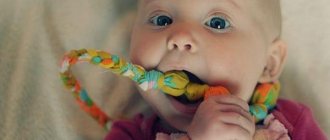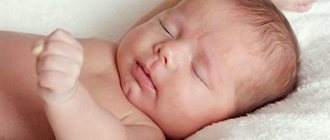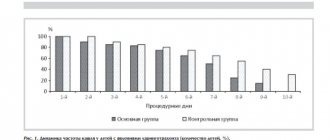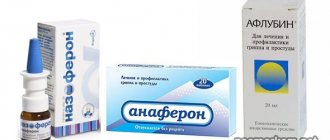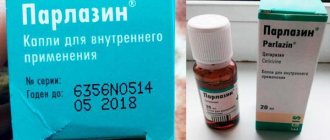Like any other pathological conditions, there can be reasons for a runny nose in infants.
- physiological;
- pathological.
Physiological reasons
The mucous membrane of the nasal cavities immediately after birth, although formed correctly, cannot fully perform its functions and participate in the regulatory mechanisms of the body. In some children, this leads to excessive dryness of the nasal cavity with insufficient secretion production, while in others it leads to excessive secretion - a newborn runny nose.
The functioning of the mucous membrane returns to normal only after reaching 10 months of age. There's no need to worry. This is not dangerous and should go away on its own over time, but the ENT doctors at Dr. Korenchenko’s clinic advise you to see a pediatrician. so as not to miss the beginning of the development of the pathological process behind the imaginary well-being.
Pathological causes
The most common cause is colds, which newborns suffer from especially often. Your own immunity has not yet been formed, and your mother’s is not always effective enough and, moreover, weakens every day. Any infection that goes completely unnoticed in an adult or older child can cause acute respiratory infections and a runny nose in a newborn.
The first symptoms of an acute infectious disease are a rise in temperature and a runny nose in the baby. Later, cough, shortness of breath, and difficulty breathing occur. Sleep and appetite disorders. The child becomes restless, cries, and refuses to eat. Excessive snot in a baby causes irritation of the skin around the nose, on the upper lip, and in the nasolabial folds. At the first appearance of such symptoms, we strongly advise you to immediately contact your pediatrician.
Another common cause of a runny nose in a newborn is an allergic reaction to an external irritant. With age and with the formation of one’s own full-fledged immune defense, this disease can go away on its own, but in infancy, intolerance to any substances is more common than in adults. Irritants can be ordinary household dust, the hair of pets or birds, foreign odors, creams and preparations that are used to treat the baby’s skin, even the smell of the mother and breast milk can provoke snot in a baby.
A relatively uncommon cause of snot in infants is vasomotor rhinitis, a disease associated with impaired blood supply to the nasal mucosa. Only a doctor can make a correct diagnosis.
Treatment
To free the nasal passages, use special microsuctions or a small enema, but only to suck out the secretions, not to rinse. The bulb or enema cannula must be inserted with caution and very shallowly, only 0.5-0.8 cm deep into the nasal passage.
Any folk or witchcraft remedies, potions or manipulations can be performed only after consultation with a doctor. Uncontrolled self-medication can harm the baby. The child is too young to take such risks!
Medicines should be used only as prescribed by a doctor, strictly following his instructions and recommendations. Only a doctor can accurately determine the child’s condition and correctly prescribe medication for treating a runny nose in an infant.
Most commonly prescribed drugs
- Aqua Maris;
- Aqualor Baby;
- Nazol Baby;
- Otrivin Baby;
- Doctor Mom;
- Salin;
- Nazivin for children.
Please note that all of the drugs listed have the prefix “baby” or “children’s”. Adult medications should not be used to treat a runny nose in an infant.
A physiological runny nose in an infant does not require treatment, but only a doctor can determine the absence of pathology. IT IS FORBIDDEN!
- use an enema to rinse the sinuses with fluid injection. A pear and an enema can only be used to suck out snot from a baby, and then only with caution;
- independently prescribe antibacterial and antiviral drugs;
- use vasoconstrictor nasal drops and sprays without consulting your doctor.
Remember! At this age, the baby's health is very fragile. By treating a baby’s runny nose on your own or using recipes from grandmothers you know, instead of improving your health, you can do a lot of harm to him.
It is impossible to leave a runny nose in a baby without treatment. If the process is pathological, the disease will progress and can cause the development of serious and life-threatening complications for the baby.
Peculiarities
Typically, a physiological runny nose in a child lasts 10-12 weeks. During this period of adaptation, the child naturally develops more mucus in the nose. There is nothing pathological about this. Such transparent mucus in the nose does not at all interfere with the baby’s ability to live an independent life and does not interfere with his ability to feed independently.
Our young mothers, due to their inexperience, are very fond of resorting to various aspiration devices to pump out mucus from the nose of their child. They think that by doing this they are somehow helping him. The child’s nasal passages are already narrow and swollen, but we still go in there with an aspirator and try to get the mucus out. Thus, we only injure the mucous surface.
If your baby has a runny nose due to being hypothermic, you can simply warm him up. And this runny nose will soon go away. A physiological runny nose does not go away so quickly. And that’s why we need to help the child. Usually we like the child to lie down all the time. We take him for walks in the stroller, he lies at home. How should this mucus move up and down in this case? Turn the baby over more often, do not forget about ventilating the room, and taking walks in the fresh air.
Prevention of runny nose in infants
See also Treatment of ENT diseases Snot in a child Chronic runny nose Treatment of rhinitis
Maintain an optimal microclimate in the room where the child is. The air temperature should be within 18-22 degrees, you cannot leave it naked for a long time, regularly ventilate the room after removing the baby from it, get rid of dust, limit the baby from contact with pets and minimize contact with strangers. Use caution when changing infant formulas when formula-feeding or when introducing supplements and complementary foods into the diet.
Teaching a baby to blow his nose
Improper nasal hygiene during a cold is the main cause of complications in preschool children. Mucus becomes a medium for the development of bacteria, which can lead to the development of complications: otitis media, sinusitis. Flowing down the back wall of the nasopharynx, thick secretions provoke a strong cough and irritate the throat. In addition, due to congestion, the body does not receive enough oxygen, which negatively affects overall well-being.
You can teach your baby to blow his nose correctly from the age of 2-3 years. But it is difficult to explain to a child the intricacies of this simple procedure. Fun and unusual exercises to help parents!
- "Let's play train
. Let your child become a magical locomotive that releases steam through its nose. Cover one “pipe” with a clean scarf and encourage them to puff heavily and blow through their nose. - "Little hedgehog".
Play with animals, invite your child to show how a hedgehog snorts when he carries an apple. While playing, close your nostrils one at a time to completely clear each nasal passage. - "Funny papers."
Cut shapes from colored paper and place on a smooth surface. The goal of the game is to blow off the leaves by exhaling air through the nose. - "Score a goal."
Unusual football will be a great exercise for children. Roll a ball out of plain paper or cotton wool and place it in the middle of the table. Players must blow on the ball with their nose, trying to score a goal for the opponent. - "Fly away, dandelion."
In summer, you can use the white caps of dandelions, but you must blow on the flower through the nose, alternately closing the nostrils, so that the child learns to control nasal breathing. In the cold season, dandelions will replace soap bubbles. - "Repeat after me".
Children happily imitate the actions of their parents. Show how to blow your nose correctly with your example. Take bright napkins, blow your nose funny and ask them to repeat it.
During training, follow simple rules:
1. You should teach your child to blow his nose only when he feels well and is not bothered by nasal congestion.
2. To maintain normal pressure, do not pinch both nostrils at the same time before exhaling.
3. Explain to your child that after blowing his nose, he must wash his hands with soap.
4. Take breaks so that the child does not become dizzy from breathing exercises.
If the child cannot immediately perform the exercise correctly, do not despair, this is absolutely normal, everything will definitely work out!
Causes
A purulent process can occur only due to damage by pathogenic bacteria. If they are absent, then suppuration will not develop. As a secondary infection, bacterial damage can occur due to exposure to allergens, fungi or viruses. Most often, purulent discharge is observed precisely with initially viral rhinitis. They can occur when the following diseases are present:
- Frontal sinusitis is inflammation of the frontal sinus mucosa. With this disease, the child suffers from particularly severe headaches and an unbearable feeling of pressure and fullness in the forehead;
- ethmoiditis - inflammation of the mucous membrane of the ethmoid labyrinth. The disease manifests itself clearly and, in addition to the discharge of pus, there is swelling of the eyes, pain around them and often especially severe between them. Also, in most cases, there is a partial loss of smell and nasal congestion;
- sinusitis - inflammation of the maxillary paranasal sinuses. Purulent mucus is most often green in color, and the unpleasant odor that comes from it is also felt from the child’s mouth. The child complains of very severe pain in the cheeks, under gases and in the area of the roots of the upper teeth. Headache, severe and greatly aggravated when the patient bends forward. The temperature and weakness of a sick child are elevated;
- sphenoiditis - inflammation occurs in the sphenoid sinuses of the nose. In children, this disease develops quite rarely and causes severe pain in the neck, ears and top of the head. The patient's health seriously deteriorates;
- purulent rhinitis - develops due to bacterial irritation of the mucous membrane of the nasal passages. The snot is yellow-green in color. They are constantly released in large volumes and lead to skin irritation in the area under the nose. It becomes painful, often covered with cracks and dry crusts.
Disease provoking factors are various reasons that affect the child’s immunity, leading to its decrease. The main ones are:
- severe hypothermia;
- stress – it can be associated with various events in a child’s life, including the start of kindergarten or school;
- frequent nose picking - with this action, the mucous membrane is regularly injured and bacteria can penetrate the tissues, bypassing the immune barrier;
- the presence of polyps or proliferation of adenoid tissue;
- chronic inflammatory diseases of the throat or nose;
- non-compliance with medical recommendations after vaccinations;
- poor nutrition, in which the child does not receive enough vitamins and minerals;
- violation of nasal hygiene rules;
- excessive dryness of indoor air.
In some cases, the cause of purulent discharge with a particularly foul odor is a runny nose. This is an atrophic form of rhinitis, which requires particularly serious treatment.
Cause of cold
Colds are caused by many respiratory viruses. Healthy children have about 6-8 colds in the first year of life. This is because there are so many viruses that cause colds. With each new cold, the child’s body develops immunity to this virus. The influenza virus causes a more severe cold with fever and muscle aches. A cold is usually a mild illness. However, with a cold, 5-10% of babies experience complications. Most often it is an ear or sinus infection that is caused by bacteria.
What to do with a runny nose when a newborn has a cold?
Most colds in newborn babies are a runny nose. After 3-4 days, nasal congestion appears. Mucus and nasal discharge perform a healing and protective function: they wash away germs from the nose and sinuses. In addition, babies cannot breastfeed or drink from a bottle properly if their nose is not breathing.
Normally, a runny nose can last about 2 weeks. There are no medications or treatments that would shorten the duration of a runny nose in a child. But there are good ways to alleviate many of the unpleasant aspects of a runny nose and prevent the development of complications. Here are some basic tips for caring for a newborn with a runny nose, which should ease his condition:
- If you have a runny nose with copious discharge, it is necessary to aspirate the nasal discharge.
- To protect the skin around the nose from irritation, it is necessary to apply a moisturizing ointment after rinsing the skin with warm water. This will help protect your nostrils from redness.
- A stuffy nose should be rinsed with saline or sterile seawater to help reduce swelling and remove mucus.
You can also use a saline nasal spray to loosen dried mucus (“crusts”). If you don't have saline solution on hand, you can make your own or use bottled water or boiled tap water.
Still have questions?
Get an online consultation from leading pediatricians in St. Petersburg!
A professional and experienced pediatrician will answer your questions.
Medical care for a child without leaving home at a convenient time.
sign up for a consultation
A Skype consultation lasts 45 minutes.
First symptoms of the disease
It is often difficult to discover that an infant is sick, because he cannot tell what is bothering him. However, in the case of a runny nose, there are quite obvious external symptoms that will help adults identify the disease in a timely manner and begin treatment.
Your baby has a runny nose if:
- he began to sneeze frequently, and his eyes began to water;
- you notice that the child has stopped breathing freely - this indicates nasal congestion. This symptom should not be ignored, because nasal congestion and, as a result, difficulty breathing at night reduces the quality of sleep and can lead to hypoxia - oxygen starvation of the cells and tissues of a growing child's body;
- mucus discharges from the nostrils. If you pay attention to the color and nature of the discharge, you can make an assumption about the nature of the disease even before consulting a doctor: clear mucus indicates a virus that has entered the body, and a thick white, yellowish or greenish secretion indicates the bacterial nature of the disease;
- in the case of infectious rhinitis, babies under one year of age may have a fever, and then treatment of a runny nose should not occur without the participation of a pediatrician.
In what other cases should you call a doctor if you have a cold?
- You think your child has a life-threatening situation
- Non-severe breathing problems that do not go away after clearing the nose.
- High-risk child (eg, with chronic lung disease)
- Weak immune system: sickle cell disease, HIV, cancer, organ transplant, oral steroid use.
- Temperature above 40°C
- Fever in a baby less than 12 weeks old.
- Ear pain or ear discharge
- Yellow or green pus from the eyes
- Fever lasts more than 3 days
- Fever returns after being gone for more than 24 hours
- Fever lasts more than 3 days or rises above 40 °C (104 °F).
- Nasal discharge continues for more than 14 days.
- Cough lasts more than 3 weeks
Do I need to use any medications from the pharmacy for a runny nose in newborns?
It is not recommended to give young children (under 6 years of age) any medicine for the common cold. The reason for this is that these medications are not safe for babies and can cause serious side effects. In addition, they are useless: they will not help remove dried mucus from the nose. Regular nasal saline solution or sterile sea water are best suited for these purposes.
Children should not be given antibiotics if they have a cold or runny nose. They don't help with colds. A doctor may only prescribe them if a child develops an ear or sinus infection.
For fever and aches, you can use acetaminophen (such as Tylenol) to treat muscle pain, sore throat, or headaches. Another option for babies over 6 months is ibuprofen, which helps reduce fevers above 39°C.
Call a doctor at home Make an appointment with a doctor or call +7 (812) 331-17-74
Can a cold be dangerous?
The most serious complication in infants is breathing problems. Respiratory failure is the medical name for difficulty breathing. The following are symptoms that should prompt you to immediately consult a doctor or call an ambulance:
- Difficulty taking every breath or shortness of breath
- Difficulty breathing so much that the baby can barely cry
- The spaces between the ribs contract with each breath
- Breathing becomes noisy (eg, wheezing)
- Breathing occurs much faster than usual
- Your baby's lips or face turn blue
- Wheezing (purring or whistling)
- Breathing occurs much faster than usual
- Swallowing problems and drooling
Prevalence and routes of infection
Most often, adenoviruses enter the body by airborne droplets, that is, in the usual way for any virus from the ARVI group. Much less often, infection occurs through contact. The child played with a sick friend's toy and then rubbed his eyes - a standard infection scenario.
In fact, the human body must protect itself from an infectious disease; immunity comes to the rescue. But in fact, weakened by the cold season, the child’s local immunity is not able to resist the virus at the main entry gate. General immunity, due to age, is also not sufficiently resistant to viral infection. This is where the statistics show that children get sick much more often than adults.
Adenoviruses account for about 17% of all cases of acute respiratory diseases. Considering that there are more than 100 viral pathogens, and that there are also bacterial pathogens, the figure on a general scale is impressive2.
Almost always, adenovirus infection occurs in the form of an epidemic outbreak, that is, a group of children in contact with each other is affected. The virus can spread throughout the body, diligently multiplying, within 1-3 weeks.
Why does pus occur?
The appearance of pus from the nose is associated with the activity of pathogenic bacteria, which secrete certain toxins by processing the mucus that accumulates in the paranasal sinuses during rhinitis. As a result of this, a special process of decay begins, due to which the mucus becomes pus and, with sufficient lumen in the sinuses, begins to be released from the nasal passage.
It is impossible to confuse pus with snot, which appears in the case of a common runny nose. Purulent mucus has a green or yellow color and a repulsive, pungent odor. Also, purulent discharge is characterized by increased density and often includes lumps of a more intense color.
In rare cases, blood is mixed with pus. This is due to the fact that in the mucous membrane, against the background of inflammation and the activity of pathogenic bacteria, a pathological process occurs, which leads to its deformation and damage. As a result, the disease easily becomes chronic if left untreated.
How to distinguish an allergic cough from a cold in a child
19.10.2021
When a child has a cough and runny nose , this does not always mean a cold. An allergic cough in a child appears similar to an infection, but the causes and treatment are different. How to recognize an allergic cough in a child?
What is a cough
Cough is a reaction of the respiratory system to irritation caused by external factors. During a cough, bronchitis , resulting in a large amount of air being expelled from the respiratory tract. This is necessary to remove another body or other irritant that is interfering with breathing. Therefore, coughing protects the airways and should not be suppressed. However, when it lasts a long time and becomes tedious, it should not be underestimated. Cough has various causes, accompanied by infections or an allergic reaction . It is difficult to diagnose an allergic cough in a child, since it is difficult to distinguish it from a cold.
Allergic cough in a child and colds
Usually the two types of cough are accompanied by the same symptoms. The child coughs, has a runny nose , may have a fever and sore throat . Both allergies and colds begin with a runny nose . In the case of a cold, these symptoms are the result of a virus attacking the body. In the case of allergies , the symptoms are runny nose and cough, and further symptoms are only the effect of prolonged exposure of the body to the allergen . When a child has a cold, the child has a fever, weakness, no appetite, and the cough is dry at first, but gradually turns into a wet cough.
With allergies a runny nose is watery, accompanied by itching and frequent sneezing. The child may develop conjunctivitis - the eyelids swell and the eyes turn red. An allergic cough in a child often turns into shortness of breath, causing breathing problems and characteristic wheezing. Such symptoms indicate the development of asthma in a child. A long-term allergic runny nose turns into a bacterial infection just like a viral infection.
Causes of allergic cough
Allergic cough is provoked by allergens - dust (dust mites), plant pollen, animal hair, mold, cosmetics, drugs. Also caused by a reaction to eating foods such as eggs, fruits, and seafood. Often an allergic reaction does not occur immediately after contact with the allergen , but a little later. When we don’t know what sensitizes the child, but suspect an allergy , it’s worth taking notes and writing down the symptoms and situations in which they appeared, for example, a runny nose after a walk or a suffocating cough while playing football or running.
Treatment of allergic cough
The cough is not suppressed because it is a protective reaction of the body, which protects itself from allergens attacking the body. When your child's allergic cough becomes more persistent, consult a doctor . The pediatrician will examine the child and, if an allergy , refer him to an allergist .
If you have an allergic cough, you will need to give antihistamines to relieve the symptoms. An allergist will do blood tests for young children or skin tests—done in children ages 3 to 4. When a positive result is obtained, the child is given the allergen in small doses in the form of an oral or intravenous vaccine, gradually increasing the dose. Thus, the body learns to tolerate the allergen . they will worsen symptoms if is allergic
Prevention and symptom relief
To relieve the symptoms of an allergic cough in a child:
- avoid allergen
- If allergic to pollen , bathe and change your child after every walk
- If you are allergic to dust, vacuum, mop, and wipe down furniture daily to remove mites and humidify the air.
- buy clothes for your child from natural materials - cotton, linen or bamboo fibers, avoid polyester or elastane
- Use a humidifier - dry air makes allergy
- rinse nose with saline or seawater, which cleans and moistens the airways
- Give your child plenty of fluids - this will hydrate the body from the inside.
- Put your child to sleep on a higher pillow, which will make breathing easier and prevent coughing attacks at night
- During the day, place your baby on his stomach and stroke his back
- strengthen your immune system
With the correct actions of an adult, the child will feel good. a doctor if necessary .
Published in Pediatrics Premium Clinic
